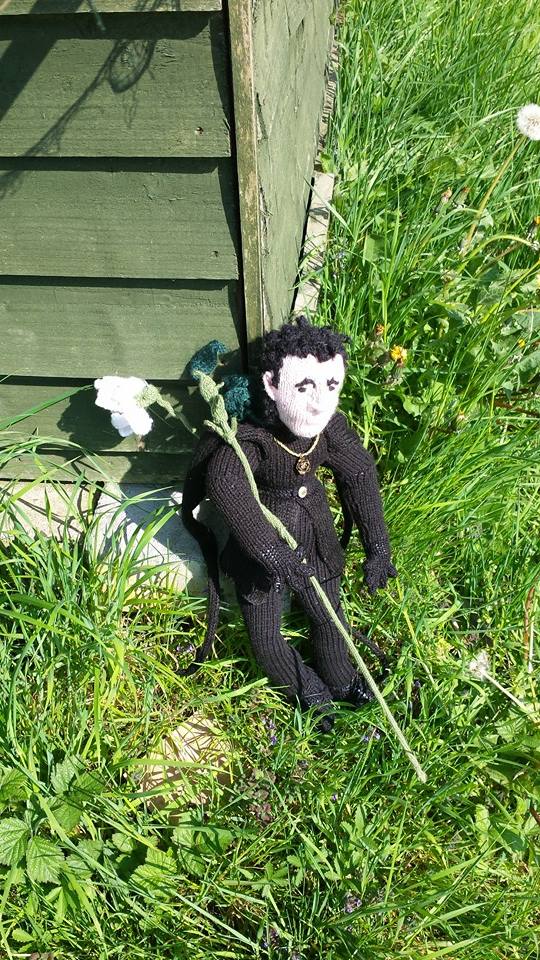Here’s flowers for you; hot lavender, mints, savoury, marjoram…
Digging for Shakespeare takes its audience on a journey that starts on a bus, proceeds through a park, wanders through a woodland, diverts into an industrial storage unit, and dallies amongst the dales of Hollingdean, which are populated with a fine array of allotments, many sporting a quaint wee shed flying an orange flag to signify that they are part of the game. Allusions to, quotes from, and ruminations upon Shakespeare’s plays and poems, and in particular his citing of flowers and herbs, crop up everywhere.
A Midsummer Night’s Dream features, of course: ‘I know a bank where the wild thyme blows…’ is inscribed on a mirror placed inside a glasshouse, with a rather rude looking Puck – or perhaps it is another fairy – in the form of a knitted doll dangles above. These mirrors and knitted dolls (Welsh artist Annie Hardy is the doll knitter) are the uniting visual motifs of the concluding allotment section of the show – which is the section the audience have most obviously come for. People in sturdy walking shoes enjoy testing their own knowledge of herbs and/or of Shakespeare. Here’s one for starters: chamomile. Yes? No? It’s King Henry the Fourth, Part One (Act 2, Scene 4): ‘For though the chamomile, the more it is trodden on, the faster it grows, yet youth, the more it is wasted, the sooner it wears.’ People nod sagely.
It all concludes with a cuppa and a tea cake as audience members swap packets of seeds – artist Marc Rees is sowing a special memorial garden for the project: there’s rosemary, that’s for remembrance.
This is all truly delightful – it’s what comes before that it less satisfactory. Because it takes a good 90 minutes to get to the allotments. Twenty minutes of this is bus journey – and yes, this is a good decision, as it gathers everyone together in one starting place, and establishes the herd mentality needed to get an audience through a lengthy outdoor promenade show. Welsh artist Marc Rees (who has a strong track-record in site-responsive performance) uses the time to tell us about himself – as we whizz past the University of Brighton, we learn that he is a graduate of the legendary Visual and Performing Arts course. He then switches mode, into character as a kind of tweed-wearing gentleman gardener, and hands out accolades for biggest marrow or sweetest smelling rose (ah, wherefore art thou Romeo…?)
When we disembark, we are taken to Hollingbury Copse, site of the now-demolished home of Shakespearean scholar James Orchard Halliwell-Phillips. Who, I’m afraid, fails to really grab my interest, despite the fact that he is a genuine English eccentric. And off we trot, to the woods, via a row of splendid flint-stone cottages. Marc Rees, in tour guide mode, delivers mini lectures and homilies throughout the journey, cribbing from notes on postcards, which bothers me. Why didn’t he learn the lines? Is he playing a postmodern game? Any decent tour guide wouldn’t use notes that he squints at constantly; and delivery of Shakespeare’s lines, and his reflections on them, is often nervous and a little faltering. Perhaps – if it is not a deliberate ploy – this will change as the show settles in.
Costumed characters pop up along the way, including regular appearances by Haliwell-Phillips (danced very prettily by Guillermo Weickert Molina). The walk through the woods is enlivened by a lovely team of young people dressed in Green Man mode (the Theatre Workshop Youth Cast), who scamper and chant and call to each other with shrill sounds that echo the loud and insistent birdcall all around us. I’m very fond of this boisterous ensemble of living plants.
Then, a lengthy ‘lecture’ section inside a storage unit which fails to engage me at all. I learn lots of facts about James Orchard Halliwell-Phillips, who obsessively catalogued all Shakespeare’s work, Charles Nicholl’s tweedy lecture embellished with OHP photos projected onto a screen. But do I care? Not a lot. Perhaps I would in other circumstances.
It feels as if there are two shows here, battling with each other: the story of the Elizabethan garden and Shakespeare’s references to herbs and plants in his plays; and the story of the eccentric scholar, Halliwell-Phillips and his obsession with cataloguing Shakespeare’s work. Yes, it’s all about Shakespeare, perhaps that’s connection enough, and yes there are attempts at merging these two main threads, but they don’t really marry well. An awkward hybrid.
At last we are let out of that darned shed and set loose to roam amongst the Roedale allotments. With heigh! the doxy over the dale… We gather gardening tips on postcards, sniff the herbs, and read the accompanying quotes. It feels like the time spent in the allotments should be the heart of the work, and thus allocated more attention and resources. Lovely though the dolls are, a bit of live performance wouldn’t go amiss here.
But it is a beautiful sunny afternoon, and everyone is so totally happy to be out and about amongst the flowers and herbs viewing the allotments, that all gripes and grudges are quickly forgotten.
Digging for Shakespeare is a dramaturgical dog’s dinner – but one full of tasty titbits.

